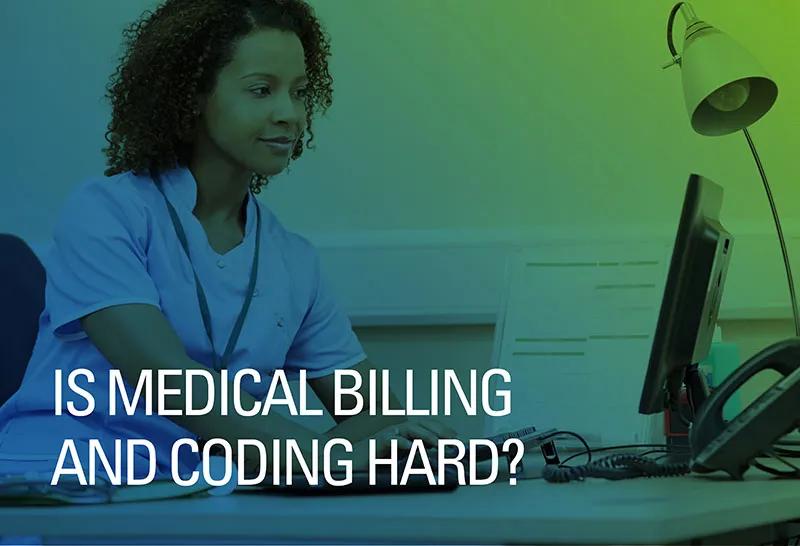Is Medical Billing and Coding Hard? What You Should Know About This Career Path

If you’re interested in working in a healthcare role and want a position that doesn’t involve direct patient care, medical billing and coding is an option to consider. However, if you’ve never done this type of work, the idea of performing billing and coding duties within the medical field may make this job seem like it could be hard to do.
If this is your concern, it can be beneficial to learn more about what it means to be a medical biller and coder. That’s why we’ve compiled a few of the things we think you need to know about this career path. And it begins with providing a clear understanding of what medical billing and coding is. This can help you decide whether you’d like to pursue this type of role.
We’ll also talk about what might make medical billing and coding a good career choice, as well as some of the reasons you may enjoy this particular healthcare role. Should you decide that you’d like to pursue a career in medical billing and coding, we even provide a few tips to help you get started. This includes giving you a glimpse of some of the classes you might take in a medical billing and coding educational program. But first, let’s begin by explaining the role of a medical biller and coder.
What Medical Billing and Coding Is
As its title suggests, this healthcare job has two parts: medical billing and medical coding. What’s the difference?
Medical billing involves submitting claims to patients’ health insurance companies for reimbursement of services or treatments provided. It also sometimes involves billing patients for their portion of the expenses not covered by their insurance provider.
When submitting these claims, instead of providing the formal names for the patient’s diagnoses, tests, or treatments, each of these is assigned a code. These codes are determined by standard medical coding systems, such as the International Classification of Diseases (ICD) and Current Procedural Terminology (CPT). Inputting these codes is the responsibility of medical coders.
For example, if a medical provider questions whether a patient may be deficient in vitamin D, they might order a blood test to check the patient’s levels of this nutrient. The CPT test code for a vitamin D blood test is 2128210.1 The medical coder would input this code into the patient’s digital medical records, also known as an electronic health record (EHR). This code not only helps keep an accurate record of the patient’s health information but also provides the information health insurance companies need when settling insurance claims.
Although some healthcare organizations hire both medical billers and medical coders, others hire one person to perform both functions. This person is titled a medical biller and coder.
Is Medical Billing and Coding Hard?
This can be a tough question to answer because what may seem hard or difficult to one person might feel easy to another. So, maybe the best way to address this concern is to share just a few of the resources that you could use to help fulfill your duties in a medical billing and coding role.
As mentioned previously, both medical billing and coding use codes as set forth by standard coding systems. These systems determine which codes to use based on the patient’s specific diagnoses, tests performed, or treatments provided.
Depending on the healthcare organization you work for, you may have access to coding programs that can help you find the correct code to use. This type of software can enable you to find the code you want simply by doing a quick computer search.
While you might start to learn certain codes from memory – especially if you use them often – access to this type of software provides you the codes you need without having to learn each one by heart. This is helpful since the ICD-10 coding system contains 71,924 procedure codes and 69,823 diagnosis codes.2 There are also more than 10,000 codes in the CPT system.3
Again, even though this huge number of codes may seem overwhelming, there are different resources available that can help you perform medical billing and coding functions.
Is Medical Billing and Coding a Good Career Choice?
One factor to consider when trying to determine whether medical billing and coding might be a good career choice for you is its job outlook or forecast. In other words, are jobs within this healthcare industry field projected to increase over the next few years, remain roughly the same, or decline?
According to the Bureau of Labor Statistics (BLS), medical records and health information specialist jobs (which is where medical billers and coders fall) are expected to grow 9% between 2020 and 2030.4 This equates to roughly 37,100 new positions4 in this time frame.
The BLS further indicates that this increase is expected due to an aging population, widespread use of EHRs, and medical registrar roles continuing to be in high demand. Combined, this equates to a greater need for medical records specialists in the years ahead.
Reasons You May Enjoy a Career in Medical Billing and Coding
How do you know whether you might enjoy working in this type of position? If you have the qualities that are important in a medical billing and coding role, you may be more inclined to find the work satisfying or fulfilling. These qualities include:5
- Being analytical
- Paying attention to detail
- Having good interpersonal skills
- Exercising discretion and confidentiality
Plus, medical billers and coders serve an important role. By using the correct codes on insurance claims, they can help healthcare providers get reimbursed at a faster rate since the claims aren’t being sent back due to incomplete or incorrect information.
Patients benefit from medical billers and coders too. When the insurance claims are submitted with the correct codes, the insurance company knows the portion it is responsible to pay. This can reduce claims that are denied and sent to the patient instead, even though their provider should have covered the service.
Using the right codes also ensures that the patient’s health record is accurate and contains the most up-to-date information. This can be helpful when being reviewed by their healthcare team to determine the best courses of action for their specific health and medical conditions.
The value you provide to healthcare organizations and patients alike can make a medical billing and coding career feel rewarding.
Tips for Pursuing a Career in Medical Billing and Coding
If medical billing and coding sounds of interest to you, you might be wondering what you have to do to pursue a career in this role. Although some employers only request that applicants have a high school diploma to work in this position, postsecondary education is typically required.6
A certificate or degree program can provide the education and skills necessary to perform medical billing and coding functions. In addition to learning about the various coding systems, you also gain other valuable skills that are helpful when performing these job duties. In entry-level medical billing and coding positions, this might entail scheduling patient appointments, reviewing insurance claims with providers, or discussing patients’ payment options.
When pursuing a medical billing and coding career, you may even want to consider where you’d like to work. You can find these types of roles within a variety of organizations within the healthcare industry, some of which include hospitals, doctor’s offices, and insurance companies.
Medical Billing and Coding Class Requirements
Each educational institution has its own medical billing and coding program requirements. That said, you will likely take classes to learn more about medical terminology, coding applications, insurance claims cycles, and more. Exact classes can also vary based on whether you’re earning a diploma or associate degree.
For example, Ultimate Medical Academy (UMA) offers both a diploma and associate degree program in medical billing and coding. The diploma program is 39-credit hours and includes courses such as:
- Diagnostic Coding for MBC (medical billing and coding)
- Procedural Coding for MBC: I and II
- Billing and Coding Application with Simulation
- Medical Terminology
- Medical Law, Ethics, and Records Management
- Healthcare Settings, Claim Cycle, and Claims Processing
UMA’s associate degree program is a 63-credit hour program that includes these same core courses. However, it also includes additional courses, such as:
- Computer Fundamentals
- Interpersonal Professional Communications
- Working with People
The Medical Billing and Coding associate degree program requires the completion of a few general education courses as well. Topics covered in these courses include English, math, biology, sociology, and critical thinking and problem solving.
Contact UMA Today to Begin Your Medical Billing and Coding Career Path
If you’re ready to pursue a career in medical billing and coding, UMA is here to help. You can enroll in either our Medical Billing and Coding diploma or associate degree program and learn the skills necessary to fill this important role.
UMA’s diploma program can be completed in 11 months and the associate degree program in 18 months.7 This enables you to choose the one that best fits your career path and goals.
Contact our Admissions team today at 888-213-4473 or you can reach us online. We are here to help in any way we can as you work to pursue your healthcare career!
FAQs
- What is medical billing and coding? Medical billing and coding involves inputting and/or retrieving codes used to identify a patient’s diagnoses, tests, procedures performed, and treatments. It also involves submitting insurance claims to a patient’s health insurance company to obtain reimbursement for the healthcare provider.
- Is medical billing and coding hard? Some might find medical billing and coding harder than others. That said, there are a number of tools and resources available to people working in these roles, such as software programs to help find the correct codes.
- Do you have to take classes to work in medical billing and coding? Whether you need a diploma or degree is dictated by the healthcare organization in which you work. While some only require a high school diploma, others might require a certain level of postsecondary education or training. Even if classes aren’t required, you may benefit from learning more about how to perform medical billing and coding functions.
- Is medical billing and coding a good career? Medical records and health information specialist jobs (which is the category in which medical billing and coding jobs fall) are expected to grow 9% between 2020 and 2030.8 This equates to the addition of roughly 37,100 new positions. So, growth-wise, now may be a good time to enter this field. You might also find this a rewarding career if you have certain qualities that are beneficial in this position, such as being analytical, being detail-oriented, and having good communication skills.9
1 HealthLab. Test Directory. Vitamin D. https://www.healthlabtesting.com/Test%20Directory/Test%20Directory%20Item.aspx?itemGuid=a6ad48a6-1aa6-44cd-ac91-3c630050408e
2 Centers for Disease Control and Prevention. National Center for Health Statistics. Background. https://archive.cdc.gov/#/details?url=https://www.cdc.gov/nchs/icd/icd10cm_pcs_background.htm
3 AMA. CPT codes, then and now. https://www.ama-assn.org/practice-management/cpt/cpt-codes-then-and-now
4 U.S. Bureau of Labor Statistics. Occupational Outlook Handbook. Medical Records and Health Information Specialists. Job Outlook. https://www.bls.gov/ooh/healthcare/medical-records-and-health-information-technicians.htm#tab-6
5 U.S. Bureau of Labor Statistics. Occupational Outlook Handbook. Medical Records and Health Information Specialists. How to Become a Medical Records or Health Information Specialist. https://www.bls.gov/ooh/healthcare/medical-records-and-health-information-technicians.htm#tab-4
6 U.S. Bureau of Labor Statistics. Occupational Outlook Handbook. Medical Records and Health Information Specialists. How to Become a Medical Records or Health Information Specialist. https://www.bls.gov/ooh/healthcare/medical-records-and-health-information-technicians.htm#tab-4
7 Completion time may vary depending on individual student.
8 U.S. Bureau of Labor Statistics. Occupational Outlook Handbook. Medical Records and Health Information Specialists. Job Outlook. https://www.bls.gov/ooh/healthcare/medical-records-and-health-information-technicians.htm#tab-6
9 U.S. Bureau of Labor Statistics. Occupational Outlook Handbook. Medical Records and Health Information Specialists. How to Become a Medical Records or Health Information Specialist. https://www.bls.gov/ooh/healthcare/medical-records-and-health-information-technicians.htm#tab-4
Request Information
Talk with us. Start your journey.
Complete this form and we'll call you to explore options at UMA and answer your questions. We'll also email you info on how to get started. We're with you at every step!
Request Information
Talk with us. Start your journey.
Complete this form and we'll call you to explore options at UMA and answer your questions. We'll also email you info on how to get started. We're with you at every step!
About the Author
 Adam Fenster
Adam FensterAdam Fenster is a senior copywriter at Ultimate Medical Academy, with journalism experience from his time as a reporter and editor for multiple online and print publications. Adam has been covering healthcare education since 2019, with an emphasis on topics such as wellness, healthcare employment, and job preparedness. He received his BA in journalism from the University of South Florida.
Related Content


